(完整word版)三年级英语教学大纲.docx
3年级冀教版英语教学大纲
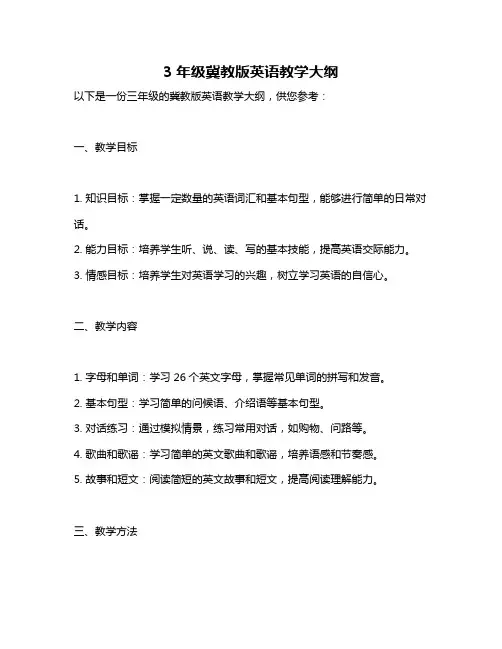
3年级冀教版英语教学大纲
以下是一份三年级的冀教版英语教学大纲,供您参考:
一、教学目标
1. 知识目标:掌握一定数量的英语词汇和基本句型,能够进行简单的日常对话。
2. 能力目标:培养学生听、说、读、写的基本技能,提高英语交际能力。
3. 情感目标:培养学生对英语学习的兴趣,树立学习英语的自信心。
二、教学内容
1. 字母和单词:学习26个英文字母,掌握常见单词的拼写和发音。
2. 基本句型:学习简单的问候语、介绍语等基本句型。
3. 对话练习:通过模拟情景,练习常用对话,如购物、问路等。
4. 歌曲和歌谣:学习简单的英文歌曲和歌谣,培养语感和节奏感。
5. 故事和短文:阅读简短的英文故事和短文,提高阅读理解能力。
三、教学方法
1. 情境教学:创设真实的语言环境,让学生在实际情境中运用所学知识。
2. 游戏教学:利用游戏激发学生的学习兴趣,让学生在轻松愉快的氛围中学习英语。
3. 任务型教学:布置任务,让学生通过完成任务来提高实际运用能力。
4. 合作学习:组织学生进行小组合作,共同完成学习任务,提高协作能力。
四、教学评价
1. 平时成绩:根据学生的课堂表现、作业完成情况等进行评价。
2. 期末考试:通过笔试和口试的形式,测试学生对本学期所学知识的掌握程度。
3. 家长反馈:及时与家长沟通,了解学生在家中的学习情况,共同促进学生的学习进步。
(完整word版)新版PEP三年级英语上册期末复习教案
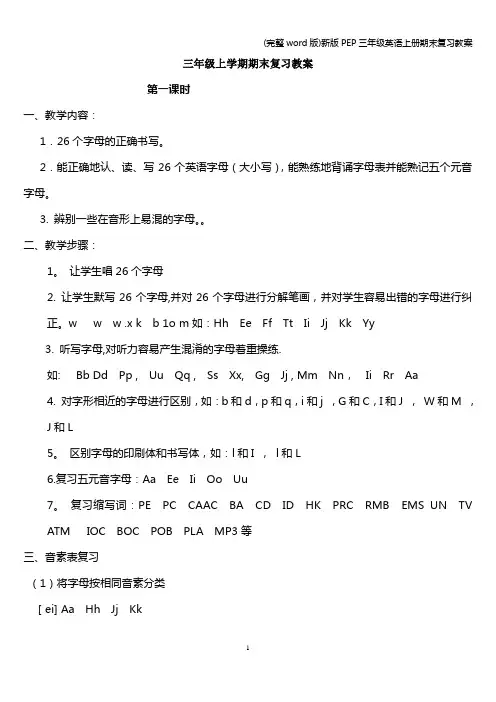
三年级上学期期末复习教案第一课时一、教学内容:1.26个字母的正确书写。
2.能正确地认、读、写26个英语字母(大小写),能熟练地背诵字母表并能熟记五个元音字母。
3. 辨别一些在音形上易混的字母。
二、教学步骤:1。
让学生唱26个字母2. 让学生默写26个字母,并对26个字母进行分解笔画,并对学生容易出错的字母进行纠正。
w w w .x k b 1o m如:Hh Ee Ff Tt Ii Jj Kk Yy3. 听写字母,对听力容易产生混淆的字母着重操练.如: Bb Dd Pp , Uu Qq , Ss Xx, Gg Jj , Mm Nn,Ii Rr Aa4. 对字形相近的字母进行区别,如:b和d,p和q,i和j ,G和C,I和J ,W和M ,J和L5。
区别字母的印刷体和书写体,如:l和I ,l和L6.复习五元音字母:Aa Ee Ii Oo Uu7。
复习缩写词:PE PC CAAC BA CD ID HK PRC RMB EMS UN TV ATM IOC BOC POB PLA MP3等三、音素表复习(1)将字母按相同音素分类[ei] Aa Hh Jj Kk[i:] Ee Bb Cc Dd Gg Pp Tt Vv[ai]Ii Yy[eu ]Oo[ju:]Uu Qq Ww[e] Ff Ll Mm Nn Ss Xx Zz[a:]Rr(2)背诵音素表四、课后练习1。
书写字母大小写.2. 写出练习中字母的左邻右舍。
新课标第一网第二课时一、教学内容:单词的复习二、教学过程:1。
诵读顺逆读26个字母(再次巩固26个字母)2. 回顾所学过的颜色的单词red green yellow blue white black orange pink 3.回顾所学过文具的单词bag pen pencil pencil—box ruler book crayon 4。
回顾所学过动物的单词cat dog fish hen duck monkey rabbit pig lion5.回顾所学过人称单词和人物单词he she they mother father grandma grandpa brother sister teacher boy girl6.回顾所学过食物单词(水果和其他)apple banana orange egg ice cream noodles7.名词复数形式的变化形式8。
外研社版三起英语三年级下册教学大纲(精)
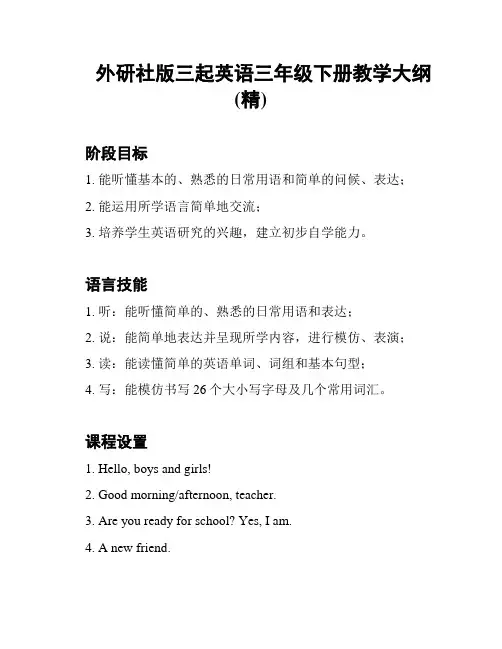
外研社版三起英语三年级下册教学大纲(精)阶段目标1. 能听懂基本的、熟悉的日常用语和简单的问候、表达;2. 能运用所学语言简单地交流;3. 培养学生英语研究的兴趣,建立初步自学能力。
语言技能1. 听:能听懂简单的、熟悉的日常用语和表达;2. 说:能简单地表达并呈现所学内容,进行模仿、表演;3. 读:能读懂简单的英语单词、词组和基本句型;4. 写:能模仿书写26个大小写字母及几个常用词汇。
课程设置1. Hello, boys and girls!2. Good morning/afternoon, teacher.3. Are you ready for school? Yes, I am.4. A new friend.Theme 2: I Love Animals1. What animal do you like?2. I like cats/dogs/birds…3. Look at them go!Theme 3: My Favorite Things1. Do you like…?2. Yes, I do./No, I don’t.3. My favorite color/food/toy.Theme 4: Happy Birthday1. Whose birthday is it?2. Happy birthday to you!3. Let’s make a birthday card.Theme 5: Let’s Play Sports1. What’s your favorite sport?2. I like football/basketball/swimming…3. Let’s play together!Theme 6: Let’s Go Shopping1. Do you want to go shopping with me?2. I want to buy a toy/book/hat…3. Can I help you?教学建议1. 建立良好的英语语言研究环境,鼓励孩子们尽可能地使用英语进行交流;2. 鼓励学生多听、多说、多唱、多读、多写,培养英语语感和语音语调准确性;3. 注重教学的趣味性,设置多元化的教学活动,丰富课堂内外活动;4. 适度减轻学生的课业负担,鼓励学生自主学习,提高学生的学习兴趣和自我管理能力。
2019年春学期小学英语(北师大版)三年级下册《Unit 8 Big bird》教案 (1)word版教案
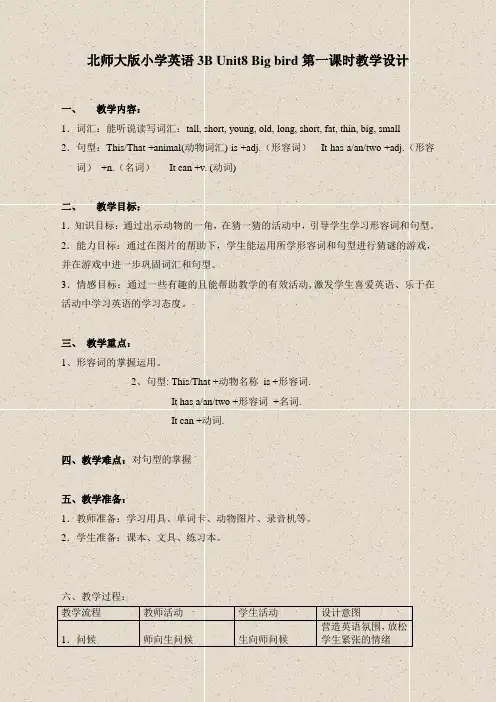
北师大版小学英语3B Unit8 Big bird第一课时教学设计一、教学内容:1.词汇:能听说读写词汇:tall, short, young, old, long, short, fat, thin, big, small2.句型:This/That +animal(动物词汇) is +adj.(形容词)It has a/an/two +adj.(形容词)+n.(名词)It can +v. (动词)二、教学目标:1.知识目标:通过出示动物的一角,在猜一猜的活动中,引导学生学习形容词和句型。
2.能力目标:通过在图片的帮助下,学生能运用所学形容词和句型进行猜谜的游戏,并在游戏中进一步巩固词汇和句型。
3.情感目标:通过一些有趣的且能帮助教学的有效活动,激发学生喜爱英语、乐于在活动中学习英语的学习态度。
三、教学重点:1、形容词的掌握运用。
2、句型: This/That +动物名称is +形容词.It has a/an/two +形容词+名词.It can +动词.四、教学难点:对句型的掌握五、教学准备:1.教师准备:学习用具、单词卡、动物图片、录音机等。
2.学生准备:课本、文具、练习本。
六、教学过程:教学流程教师活动学生活动设计意图1.问候师向生问候生向师问候营造英语氛围,放松学生紧张的情绪2.创设情境进行旧知的检查和导入新课1.利用上一个单元所学句型“Do youlike …?”来引出动物,并同时交代评价方法。
1.能针对师的问题进行回答,并挑选出每一个小组的代表动物进行比赛。
用已知的知识作新课的铺垫,更利于学生理解和学习新的知识同时评价的引入更能激发学生学习英语的激情3.新课导入1.手持漏出一角的动物卡片,让生猜出动物名称并在评价上给予奖励。
2.利用猜出动物的特征,进行形容词和句型的学习1.能根据师出示的卡片特征,积极参与猜的活动。
2.在图片帮助下,理解和运用所学形容词和句型利用孩子们喜欢参与的猜一猜活动创设的情境,并在情境中教授语言知识,更有利于语言的理解和运用4. 新课学习1. 描述黑板上的卡片,如:a small bird,afat pig等。
(完整word版)新版PEP小学英语三年级上册全册英语电子教案

2017- 2018 学年度第 1 学期教案
学科:英语
年级:三年(上)
教师:
课时计划
______年___月___日
课时计划
___年___月___日
课时计划
___年___月___日
课时计划
___年___月___日
课时计划
___年___月___日
课时计划
___年___月___日
课时计划
___年___月___日
课时计划
___年___月___日
1.
2.
课时计划
___年___月___日
课时计划
___年___月___日
课时计划
___年___月___日
课时计划
___年___月___日
课时计划
___年___月___日
课时计划
___年___月___日
课时计划
___年___月___日
课时计划
___年___月___日
课时计划
___年___月___日
课时计划
___年___月___日
课时计划
___年___月___日
课时计划
___年___月___日
课时计划
___年___月___日
课
时 计 划
___年___月___日
课时计划
___年___月___日
课时计划
___年___月___日。
新版小学三年级英语上册 三年级(上)新版义务教育教科书英语教案(书面完整版)
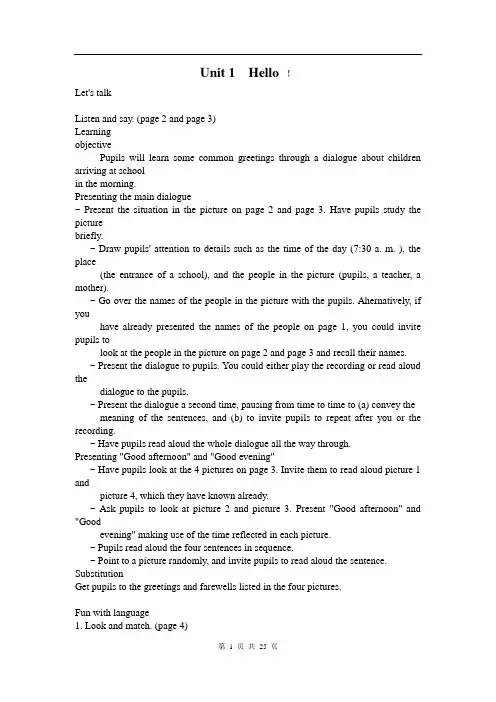
Unit 1 Hello !Let's talkListen and say. (page 2 and page 3)LearningobjectivePupils will learn some common greetings through a dialogue about children arriving at schoolin the morning.Presenting the main dialogue~ Present the situation in the picture on page 2 and page 3. Have pupils study the picturebriefly.~ Draw pupils' attention to details such as the time of the day (7:30 a. m. ), the place(the entrance of a school), and the people in the picture (pupils, a teacher, a mother).~ Go over the names of the people in the picture with the pupils. Ahernatively, if youhave already presented the names of the people on page 1, you could invite pupils tolook at the people in the picture on page 2 and page 3 and recall their names.~ Present the dialogue to pupils. You could either play the recording or read aloud thedialogue to the pupils.~ Present the dialogue a second time, pausing from time to time to (a) convey the meaning of the sentences, and (b) to invite pupils to repeat after you or the recording.~ Have pupils read aloud the whole dialogue all the way through.Presenting "Good afternoon" and "Good evening"~ Have pupils look at the 4 pictures on page 3. Invite them to read aloud picture 1 andpicture 4, which they have known already.~ Ask pupils to look at picture 2 and picture 3. Present "Good afternoon" and "Goodevening" making use of the time reflected in each picture.~ Pupils read aloud the four sentences in sequence.~ Point to a picture randomly, and invite pupils to read aloud the sentence. SubstitutionGet pupils to the greetings and farewells listed in the four pictures.Fun with language1. Look and match. (page 4)LearningobjectivePupils will practise the words morning,evening through a matching task.~ This task revises the vocabulary items morning, afternoon, and evening that pupils haveIlearnt on page 3.~ Ask pupils to read aloud the three words below the pictures.~ If necessary, ask pupils to look at the first picture, and say " Morning? Afternoon? Evening?", pointing to the three words while saying them. Pupils will then understand theidea of matching pictures to the right words.~ Explain the task to pupils, demonstrating with one picture if necessary.2. Listen and number. (page 4)Learning objectivePupils will practise the common greetings they have learnt through a listening task.~ This task practises the expressions presented on page 2 and page 3. Revise these expressions with pupils if necessary.~ Ask pupils to look at the example picture, and invite pupils to guess what the people in thepicture are saying.~ Ask pupils to look at the other pictures, drawing their attention to the time of the day ineach picture. Invite pupils to guess what the people in each picture are saying.~ Explain the task. Then play the recording, or read aloud the sentences yourself, for pupilsto complete the task.~ Extension: As a follow-up activity, you may ask pupils to repeat the sentences after therecording after you have checked the answers with them.Sing alongListen and sing. (page 6)Learning objectivePupils practise the greetings they have learnt so far through singing a song. Suggestions~ This activity provides further practice of the expressions pupils have learnt so far in theunit.~ Ask pupils to look at the picture on the page. Present boys and girls using the picture.~ Help pupils understand that Ms White and the children are greeting each other.~ Read aloud the lyrics of the song, line by line, for pupils to repeat after you.~ Play the recording of the song. Ask students to look at the lyrics while listening to therecording.~ Play the recording again, and invite pupils to sing along with the recording.~ Extension: If you like, you can ask the pupils to sing the song again, changing Ms Whiteto your own name.Sound familyLearningobjectiveTo recognise and read aloud the letters A/a to H/h in both upper case and lower case.1. Listen and read. (page 7)Ask pupils to look at the letters A/a to H/h. Play the recording. Pupils listen and repeateach letter after the recording.2. Listen and point. (page 7)~ In this activity, the letters Aa to Hh are hidden in the picture. Some of them are shown inupper case; some are shown in lower case. Pupils listen to the recording and point at eachletter that they hear.~ Point to any letter in the picture, and ask pupils to say the letter.Rhyme time ( page 7)LearningobjectiveTo practise the letters A to H through a rhyme.~ The rhyme contains a new structure This is, and the expression Say after me, which youmay have used in the classroom incidentally. As the main objective is to practise the lettersA to H, simply present the whole rhyme as a while.~ Play the recording once all the way through. Play the recording again, pausing after everyline for pupils to repeat.~ Pupils then read the rhyme all the way through.~ Extension: To increase interest and/or for further practice, divide the whole class into twogroups,, who will read aloud the rhyme as follows:GroupA, B, C, D.A, B, C.GroupThis is A,This is B.GroupE,F,G,H.E, F, G.Group B:Say after meSay after me.Unit 2 How are you?Let's talkListen and say. (page 8 and page 9)Learning objectives~ To learn the expressions "How are you", "Fine", and "Good night" through listening toand practising a dialogue.~ To learn the vocabulary items dad, grandpa and grandma.Suggestions~ Ask pupils to look at the family picture on page 8. Invite them to recall the name of theboy.~ Point to Ben's Dad on the right of the picture and introduce Dad.~ Take this opportunity to introduce grandpa and grandma on page 9, by saying "dad's dadis grandpa" and "dad's mum is grandma".~ Draw pupils' attention to details in the picture (seven o'clock; Ben playing at home; Dadreturning home) to convey the meaning of the picture.~ Ask pupils to look at the family picture on page 9. Draw pupils' attention to details in thepicture (Mum and Dad waving; Ben lying in bed) to convey the meaning of the picture.~ Present the dialogue. Play the recording, or read aloud the dialogue to the class.~ Play the recording again, pausing after each speech bubble for pupils to repeat.~ Substitution : Substitute Dad in the dialogue with "mum", "grandpa" and "grandma".Have pupils practise the dialogue in pairs.~ Extension: Ask pupils what to say at different times of the day as a recycling task. Fun withlanguage1. Look and match. (page 10)Learning objectiveTo revise vocabulary of family members: dad, mum, grandpa, grandma. Suggestions~ Go over the five pictures on the left with pupils, stating the word representing each picture.~ Have pupils look at the 5 words on the right. Invite them to read aloud the words. Providehelp if necessary.~ Say a word from the list, and ask pupils to point at the word..Pupils practise listening to dialogues containing the greetings that they have learnt so far inthis module.Suggestions~ Choose one of the four pictures. Get across the idea that the two people in the picture aretalking to each other.~ Invite pupils to guess what the two people are saying to each other. You could jog pupils'memory by providing them with some of the expressions that they have learnt so far. ~ Explain the task, i.e. they should match the dialogue they'll hear to the appropriate/correct picture. If necessary, use the first mini-dialogue in the recording as an example.~ Assessment: When pupils have finished the task, you could invite them to recall what thepeople in each picture say to each other.~ Extension: Call out different events and ask pupils to say what greeting/farewell shouldbe used (can use Chinese for explanation). Some examples of events: see a friend at ashop in the morning; leaving school in the afternoon, etc.3. Look and say. (page 11)Learning objectivePupils will revise all the expressions they have learnt in this module.Suggestions~ Explain what is going on in Picture 1. Then ask pupils to look at picture 2, study thedetails, and try saying the sentences from the picture.~ Repeat the same procedure with the remaining pictures.three minutes to work out the sentences themselves.pairs.You could also give pupils two orThey could do this individually or inAnswer key (accept every reasonable answer)2. Good bye, Mum.3. Good morning, Ms White.4. Hi.5. Good bye.6. Good evening, grandma.7. Good evening, Dad.8. Good night, Mum.4. Do the project. (page 11 )Learning objectivePupils will use all the expressions they have learnt in this module in greeting each other.~ Explain Step 1 and Step 2 to pupils.~ There are different ways to conduct Step 3. The important thing is that each mini-dialogueshould make sense.Story timeRead and act. (page 12)LearningObjectiveunderstand all the sentences in the story text, so avoid over-explaining the story to the pupils.~ This story will introduce a character, Aki the Alien, who will appear again and again inlater stories.~ In the story, different insects meet and greet each other at different time of the day. Atnight time, a firefly comes out to play. He wants to greet the other insects but they are allasleep. He is getting bored when at this point, Aki the Alien appears and greets him enthusiastically.~ Pupils need not know the English names of the insects to understand the story.~ Motivate interests in the story. Draw pupils' attention to the arrows that will show thesequence of the pictures as they read.~ Then have them read the story text silently on their own.~ When they have finished, ask them whether they like the story.~ Play the recording of the story.~ Invite groups of students to act out the story.Did you know?Greetings around the world. (page 13)LearningobjectiveTo learn about the practices of greetings in other parts of the world.~ Revise with pupils the expressions of greetings introduced in this module.~ Invite pupils to talk about how they greet each other in everyday life.~ Ask pupils to read page 13 to find out about how people in other parts of the worldgreeteach other.~ Ask pupils to guess where the people in each picture are. (They can use Chinese. )Unit 3 What's your name?Let's talkListen and say. ( page 14)LearningobjectivesTo learn the expressions for:~ introducing oneself to others;~ asking people their names.Presenting the main dialogue~ Ask pupils to look at the picture on page 14. Draw their attention to the date on the noticeboard (the 1 st of September).~ Invite pupils to recall the names of the two boys in the picture.~ Draw pupils' attention to the gestures of the two boys to get across the idea that they aregreeting and introducing themselves to each other.~ Present the dialogue by reading it aloud to the pupils, or playing the recording. Whiledoing this, point to the boy who is saying each line.~ Present the dialogue a second time, pausing from time to time to (a) convey the meaningof the sentences, and (b) to invite pupils to repeat after you or the recording.~ Have pupils read aloud the whole dialogue all the way through.~ Extension: Invite pairs of pupils to read aloud the whole dialogue to the wl~ole class.Presenting the names of the other children~ Invite pupils to recall the names of the two boys.~ Go on to point to the other children on page 15 to signal that you are going to present thenames of them.~ Point to each child in the picture and say his/her name. Trace the balloon to highlight thewritten form of the name. Ask pupils to say the name after you.~ Repeat the above procedure for the other children in the picture.~ For further practice, ask pupils to read aloud the names from left to right first in sequence,then out of sequence.SubstitutionGet pupils to repeat the dialogue in pairs using the names in the balloons.Fun withlanguage1. Listen and match. (page 16)Learning objectivesTo listen to some English names and recognise the written words that represent them. ~ Have pupils look at the pictures of the children. The names of the 6 children have beenpresented on page 15.~ Encourage pupils to read aloud the names of the 6 children. After one or two attempts, youcould invite pupils to cover the written names, and say aloud the names of the children bylooking at the pictures only.~ Revise the letters A to F with pupils.~ Demonstrate to pupils how to complete the task, using Tom as an example.~ Play the recording for pupils to complete the task.TapescriptA. TomB. JanetC. BenD. MikeE. KateF. AnnAnswer key2. Choose and say. (page 16)Learning objective~ To practise introducing oneself using "My name is ...".~ To revise using "Hi" and "Hello" to greet someone.Suggestions~ Module 2 Introductions~~ Ask pupils to look at page 14 again to find out how Jiamin introduces his name to Ben.~ Help pupils select an English name and then introduce themselves.~ Invite pupils to tell the class their names by saying My name is ... when each pupil hasdone this, say to him/her Hello and then his/her name.~ Repeat Step 3 above. This time, point to a pupil, who will then say My name is ... to thewhole class. The whole class then greet him/her by saying Hello and then his/her name.~ Have pupils study the pictures in Choose and say on page 16. Explain the task to pupilsusing the two pictures.~ Ask pupils to write their English names on a sheet of paper, which they will use later inintroducing themselves. They will then practise introducing themselves to theirYou could follow the exampleof the pictures and invite groups of pupils to perform the taskin front of the class, or invite half of the class to walk around the classroom to introducethemselves to the other half who remain seated.3. Play the game. (page 17)Learning objectiveTo practise (a) telling one's name to others, and (b) asking others their name.~ The question What's your name? appears for the first time in this module.~ Conduct a mini dialogue with a few pupils as follows during which you will get across themeaning of What's your name? to the pupils:II You: My name is Mr/Ms ... What's your name?m Pupils: My name is ...~ Have pupils look at the pictures in Play the game on page 17. Go over the 3 pictures insequence to explain the game. (Have each group use a ball or ruler, then pass it from oneto the other. The one with the ball or ruler needs to introduce themselves.')~ Invite groups of pupils to try the game in front of the class. Increase the number of pupilsinvolved in each round gradually.4. Look and act..( page 17)LearningobjectiveTo practise telling others one's name and asking others their name through a fun activity.~ Pupils will reinforce the expressions they have practised through an acting activity. Highlight the acting element when you set up the activity.~ Ask pupils to look at the pictures in Look and act on page 17. Point to Snow White in thefirst picture. Check whether pupils already know the name Snow White. If they don't,present the name to the pupils.~ Repeat Step 2 above with the second picture.~ Tell pupils you now want some of them to be Snow White and Monkey King. Invite 2 pupilsto do a demonstration in front of the class. Encourage pupils to act as Snow White andMonkey King.~ Extension: Invite pupils to suggest other characters that they know. They then continuethe acting activity using these other characters.Listen and sing. (page 18)LearningobjectiveTo further practise expressions for greeting others and introducing oneself through singing a~ Ask pupils to study the picture on page 18 and identify Janet and Xiaoling in the picture.~ The song contains a new expression: It's nice to meet you (too). Use the picture to convey the idea that Janet is happy to meet her new classmates, so she says It's nice tomeet you to them.~ Read aloud the lyrics to the pupils. Ask them to repeat each line after you.~ Play the recording. Then play the recording again for pupils to sing along with the recording.~ Extension: Get students to use classmates' names they like to sing the song again. Sound familyLearningobjectiveTo recognise and read aloud the lettersI/I to Q/q in both upper case and lower case.1. Listen and read. (page ]9)Suggestions~ Ask pupils to look at the letters I/i to Q/q. Play the recording. Pupils listen and repeateach letter after the recording.~ Write the same letters on the board. Point to the letters randomly for pupils to say themaloud.2. Listen and join the dots. (page 19)Learning objectiveTo revise the letters A/a to Q/q.Suggestions~ This task covers all the letters that pupils have learnt so far.~ If necessary, revise A/a to H/h with pupils.~ Invite pupils to look at the picture, drawing their attention to the tree and the shape of theanimal. Motivate interest by inviting pupils to guess what animal it is.~ Explain the task by demonstrating the first few letters (e. g. , A -P- C) that pupils willhear. (Pupils should draw a line between each of the letters they will hear. )~ Play the recording for pupils to complete the task.~ After you have checked the answer with the pupils when they have finished you couldconduct further practice by asking them to read aloud the letters in the correct sequence inthe picture.TapescriptA-P-C - D-I-E -N-B -J-H -K-M -F- Q- G-L-OAnswer keyA giraffe.Rhyme time ( page 19)Learning objectiveTo practise some of the expressions learnt so far through a rhyme.Suggestions~ The rhyme contains no new language items. Pupils should have no difficulty understandingthe rhyme.~ The words in the rhyme are Ben, Ken, and friends. Emphasise those appropriately whenpresenting the rhyme.~ Explain to pupils that the children are happy to meet each other, and they are now sayinga rhyme about their new friends.~ Play the recording all the way through.~ Play the recording again, pausing after each line for pupils to repeat. Remind pupils of therhythm.~ Pupils read aloud the rhyme all the way through. For further practice, divide the class intotwo groups. One group will read the first two lines and the other group will read the nexttwo lines. Then both groups read the last two lines together.Unit 4This is my dadLet's talkListen and say. ( page 20 -- 21 )Learning objectiveTo learn how to introduce one person to another through a dialogue.~ Ask pupils to study the picture on page 20. Draw pupils' attention to the time of the day(4:40 o'clock), and other details that depict the situation: Jiamin carrying hison his back, ready to go home; Ms White waving goodbye to Jiamin, Jiamin's dad pickinghim up from school, etc.~ Convey the idea that Ms White and Jiamin's father do not know each other yet. Jiamin isnow introducing them to each other.~ Play the recording all the way through.~ Play the recording again, pausing after each speech bubble for pupils to repeat.~ Draw pupils' attention to the expression that Jiamin uses to introduce Ms White and his dadto each other: This is ...~ Now ask pupils to look at page 21. Ask pupils to recall the name of the other boy.~ Repeat the above procedure for presenting the second half of the dialogue.~ If pupils need further practice, you could invite groups of 3 pupils to read and act out thedialogue (the first half or the second half) in front of the class.~ You could also use the pairs of names on pages 20 and 21 (mum &Xiaoling; Mike &grandpa; grandma & Janet) for pupils to act out a similar dialogue between the child andMs White.~ Substitution: Get the class to read the dialogue aloud using the new character pairs (mumand Xiaoling, Mike and grandpa, etc. ), to replace Jiamin and his dad.Fun with languagePlay the game. (page 22)LearningobjectiveModule 2 IntroductionsTo practise introducing oneself with I am ..., and practice identifying a person with Thatis ... through a game.~ Ask pupils to look at the pictures on page 22. Present the scenario to pupils using thepictures. Read the sentence in the third picture ( That is Sam) with appropriate emphasis.~ Explain the game again with the help of 3 pupils. When you get the guessing part, encourage pupils to make the guess using the expression That is ...~ Continue to play the game with groups of 3 pupils.~ Extension: Get pupils to make paper masks to cover their faces and do the guess usingThat is .../ This is ...2. Show and say. (page 22) --Pre-class preparation (pupils required)objectiveTo practise introducing one's family members using This is ...~ Pre-class preparation: Ask pupils to bring a photograph of their family to the next lesson.~ Revise dad, mum, grandma and grandpa, using the pictures of pages 20 and 21 if necessary.~ Ask pupils to look at the picture on page 22. Check if pupils understand that the twochildren are looking at a photograph.~ Get across the idea that the boy is introducing his family members to the girl.~ Read out the boy's lines, or invite some pupils to read out the boy's lines.~ Invite one pupil to give a demonstration by introducing the family members in the photograph that he/she has brought to class.~ Extension: Get pupils to introduce members in their pictures to each other.3. Look and act. (page 23)LearningobjectiveTo practise introducing two people to each other in a simulated real-life situation.~ In this activity, pupils imagine that they run into each other in a public place, such as apark. They then introduce their family members.~ Ask pupils to look at the picture on page 23, drawing their attention to the place.~ Invite pupils to identify Janet and Jiamin in the crowd.~ Draw pupils' attention to Janet's grandpa, who is standing next to her.~ Present the scenario in the picture to pupils.~ Invite groups of pupils to act out the scenario in front of the class.~ Extension: change Janet or Jiamin to another child; change grandpa to grandma. 4. Do the project. (page 23)LearningobjectivePupils will make a name card of themselves and practise introducing themselves to others.~ Ask pupils to study the name card on page 23 to get an idea of what it is. Introduce theword name card.~ Ask questions to elicit the content of the name card: the owner's English name, her school, and her class.~ Explain the task. Give pupils time to make their own name card. Encourage them to addartwork to it if time allows. )klternatively, this step could be done at home.~ When pupils have their name cards ready, invite them to take their own name card andintroduce themselves to each other. This can be done as a milling activity, that is, thewhole class will stand up and walk around making exchanges with whoever they meet.Alternatively, collect all the name cards. Then draw a card from the stack. The pupilwhose name card is drawn will introduce himself/herself to the whole class.Story timeRead and act. (page 24)LearningobjectiveTo read with understanding a story that contains some of the expressions that pupils havelearnt so far.20~ In this story, the children meet each other in a strange place and introduce themselves toeach other. Finally, they meet Aki, who has a funny name and is from space.~ Ask pupils to look at the pictures briefly to find out the characters involved. Invite pupils to tell the names of the characters they have recognised.Module 2 Introductions~~ By making use of one or two of the pictures, get across the idea that the children are in astrange place and they do not know each other.~ Check if the pupils understand the sequence of the pictures.~ Play the recording. Pupils read the story text while listening to the recording.~ Explainnny and space. Ask pupils to read aloud the story text in chorus.~ Extension: Get pupils to work in groups to act out the story.Did you know? ( page 25 )LearningobjectiveTo learn about how names are stated in different countries.SuggestionsI~ Introduce the terms family name and given name, using your own name or the names oftwo or three pupils.~ Ask pupils to look at the 3 pictures on page 25. Invite them to find out the family name ofeach person. You could ask pupils to underline the family name of each person.~ The above steps will show pupils the different positions of the family name in differentcountries.~ Repeat the above steps for given name.~ Zoom in on the first picture, and draw pupils' attention to the middle name. Explain topupils that today the middle name is used in formal contexts only.~ If you like, you could show pupils how to read the 3 names.~ Extension: Use pupils self-selected English names and family names to highlight positiondifference between western and Chinese name convention.Module 3 BodyModule overviewUnits and thematic contentIn Unit 5, Ben returns home for dinner. He looks dirty,so his mum and dad ask him toclean up before having dinner.In Unit 6, Ms White plays a game with the children which requires them to listen to andfollow her instructions correctly.22Grammar and communicative functionsImperatives for giving instructions,e.g.,~ Wash your hand.~ Clean your nose.Negative imperatives for prohibitions, e. g. ,Don't touch your eyes. Common expressions:~ Oh.~ Okay.~ Oh not~ And ...~ too~ Let's ...Plural form of countable nouns, e. g. , eyes, handsIrregular plural form of countable nouns:Possessive pronoun: youV ocabularyVerbs:wash, touch, clean, brush, open, close,feetNouns :face, eye, hand, ear, feet, teeth, head, hairAdjective:earlyWords in context:game, tail, turn (n.), Simon SaysPhonicsThe letters R/r to Z/z.Learning outcomesPupils will be able to:~ refer to parts of the body;~ understand and give simple commands by using the imperative;~ refer to things and people using the demonstratives this and that;~ recognise the letters R/r to Z/z.Unit 5 Wash your faceLet's talkListen and say. (page 26)LearningobjectiveTo be introduced to parts of the body and simple imperatives.Presenting the main dialogue~ Have pupils study the picture on page 26 and page 27. Invite them to recall the name ofthe boy (Ben). Ask pupils who the other people in the picture are (Ben's mum and Ben'sdad).J~ Convey the context by drawing pupils' attention to the following details: Ben looks dirty;Ben returning home from outside; the time of the day; the table being prepared for dinner,etc.~ While talking about Ben's appearance, present eyes, hands, and face.~ Prepare pupils for the listening by asking What are Ben's mum and dad saying to him.~ Play the recording all the way through. Pupils look at the dialogue text while listening.Check if they are following the correct speech bubbles.~ You could now repeat the dialogue sentence by sentence, taking this opportunity to presentthe meaning of the imperatives.~ Play the recording again, or read the dialogue again, sentence by sentence for pupils to。
(完整word版)上海版牛津英语三年级上册教案m3Unit1Myschool
Module 3 Places and activitiesUnit 1 My schoolPeriod OneTeaching contents: Look and sayTeaching Aims:1. 知识目标:1) Using nouns to identify things2) Asking Wh- questions to find out about a specific thing 2. 能力目标:1) Open an interaction by eliciting a response2) Maintain an interaction by providing information to factual questions3. 情感目标:通过对学校的介绍激发学生对学校对班级的热爱Difficult and key points:1) New words: school, classroom, hall, toilet, office, playground, library2) New sentences:What’s this? It’s a /the ______. Is this a/the _________? Yes/No Teaching aids: tape, some pictures, word cardsModule 3 Places and activitiesUnit 1 My schoolPeriod TwoTeaching contents: Point, ask and answer Listen and actTeaching Aims:1. 知识目标:1) Asking yes/no questions to obtain simple responses2) Using imperatives to give instructions3) Asking Wh-questions to find out about a specific thing 2. 能力目标:1) Open an interaction by eliciting a response2) Maintain an interaction by providing information3) Maintain an interaction by using formulaic expressions to acknowledge, agree or disagree3. 情感目标:通过问答加深对学校的了解,通过学习课堂用语做到整齐划一Difficult and key points:1) Listen and respond2) Wh- questions: What’s this? It’s a /the _____.3) yes/no questions: Is this a / the ______?Yes, it is. No, it isn’t.Teaching aids: tape, some pictures and labelsTeaching procedure:Module 3 Places and activitiesUnit 1 My schoolPeriod ThreeTeaching contents: Play a matching game Learn the sounds Teaching Aims:1. 知识目标:1) Using plural forms of nouns to identify things2) Using numbers to show quantities3) Using formulaic expressions to express approval4) Pronounce correctly words in isolation with initial sounds / ei /& /æ /2. 能力目标:1) Discriminate between words with vowel sound ‘a’ in both open and closed syllable forms2) Use modeled phrases to communicate with other learners3. 情感目标:鼓励学生相互协作,懂得对他人的赞赏Difficult and key points:1) Numbers: from one to ten2) Plural forms of nouns: desks, chairs….3) Vowel sound: A a--/ ei /& /æ /Teaching aids: tape, some pictures cards and number cardsTeaching procedure:教学目标课程标准:根据教学目标,学生心趣为先,激励和培养孩子们学习英子们在听说玩演练中学会本课内容1.能听懂、会说几种家庭成员brother, sister, me及little和big2.能够在实际语言情境中运用is…能正确区分he和she并能熟3.培养学生热爱自己的家庭4.注重合作学习,培养学生教学重点及解决措施教学重点是本课时表示家庭成员的解决措施:1、通过创设情景,布置任务2、运用多媒体课件,创设出各种中逐步熟练掌握教学难点及解决措施教学难点是能够在实际语言中运用解决措施:1、通过创设情景,布置任务2、运用多媒体课件,创设出各“用”中逐步熟练掌握教学设计思路以课本教材为基础,综合整个单元启后,螺旋上升。
小学英语课程教学大纲
小学英语课程教学大纲一、课程目标1. 帮助学生建立基本的英语语言学习兴趣和积极性。
2. 帮助学生掌握英语的基本语音、词汇、语法和语用知识。
3. 培养学生的听、说、读、写能力,提高他们的英语综合运用水平。
4. 培养学生在英语学习中的语感和语感应用能力,提高他们的语言表达能力。
5. 培养学生的跨文化意识和跨文化沟通能力,拓展他们的国际视野。
二、教学内容1. 语音:学习基本的英语语音知识,掌握英语各种音节和音素的发音规律。
2. 词汇:学习日常生活中常用的英语单词和短语,积累词汇量。
3. 语法:学习英语的基本语法知识,掌握句子结构和语法规则。
4. 阅读:学习阅读英语简单的文章和故事,培养阅读能力。
5. 听力:进行听力训练,提高学生听力理解能力。
6. 口语:进行口语练习,提高学生口语表达能力。
7. 写作:进行写作练习,培养学生书面表达能力。
三、教学方法1. 情景教学法:通过情景创设,激发学生的学习兴趣。
2. 任务型教学法:通过任务设置,激发学生学习动力,并提高实际运用能力。
3. 多媒体教学法:利用多媒体资源,丰富课堂教学内容,提高教学效果。
4. 合作教学法:通过小组合作学习,培养学生的团队合作意识和交流能力。
四、教学评价1. 考核方式:定期考试、作业评定、课堂表现评价等多种方式综合评定学生英语学习情况。
2. 教学效果评估:定期进行教学效果评估,及时调整教学方法和内容,确保教学质量。
五、教学保障1. 师资保障:配备合格的英语教师,定期进行教师培训,提升师资水平。
2. 教材选择:教学教材丰富多样,符合学生英语学习需求,充分体现教学内容和教学目标。
3. 教学设施:提供整洁、安全、舒适的教学环境,配备必要的多媒体教学设备。
六、总结通过本小学英语课程教学大纲的制定和实施,旨在帮助学生全面提升英语水平,培养其英语语言表达能力和综合运用能力,促进学生的跨文化交流和国际视野拓展。
同时,借助多种教学手段和方法,灵活开展教学活动,激发学生的学习兴趣和动力,确保教学效果的最大化。
小学英语教学大纲模板范文
小学英语教学大纲模板范文Teaching English to elementary school students is a crucial aspect of their education. It not only equips them with essential language skills but also opens up doors to a world of opportunities. 小学生学习英语是他们教育中至关重要的一部分。
这不仅能够让他们掌握基本的语言技能,还能够为他们打开一扇通往更广阔机会的大门。
One of the key components of an elementary school English teaching syllabus is vocabulary building. This involves introducing students to new words and helping them understand their meanings in context. Vocabulary building activities can include flashcards, games, and interactive exercises. 小学英语教学大纲的一个关键组成部分是词汇积累。
这涉及到让学生接触新的单词,并帮助他们理解这些单词在语境中的意义。
词汇积累活动可以包括单词卡、游戏和互动练习。
Another important aspect of teaching English to elementary school students is grammar instruction. By teaching students the rules of grammar, educators help them form coherent sentences and express themselves effectively. This can be done through exercises, worksheets, and group activities. 给小学生教授英语的另一个重要方面是语法教学。
(完整word版)人教版精通英语三年级下册教案
三年级英语学科课时备课教案A:基本要求(听、说、读、写,演、画、唱) B:高级要求(理解和运用)三年级英语学科课时备课教案A:基本要求(听、说、读、写,演、画、唱) B:高级要求(理解和运用)三年级英语学科课时备课教案A:基本要求(听、说、读、写,演、画、唱) B:高级要求(理解和运用)三年级英语学科课时备课教案A:基本要求(听、说、读、写,演、画、唱) B:高级要求(理解和运用)三年级英语学科课时备课教案A:基本要求(听、说、读、写,演、画、唱) B:高级要求(理解和运用)三年级英语学科课时备课教案A:基本要求(听、说、读、写,演、画、唱) B:高级要求(理解和运用)三年级英语学科课时备课教案A:基本要求(听、说、读、写,演、画、唱) B:高级要求(理解和运用)A:基本要求(听、说、读、写,演、画、唱) B:高级要求(理解和运用)A:基本要求(听、说、读、写,演、画、唱) B:高级要求(理解和运用)A:基本要求(听、说、读、写,演、画、唱) B:高级要求(理解和运用)A:基本要求(听、说、读、写,演、画、唱) B:高级要求(理解和运用)A:基本要求(听、说、读、写,演、画、唱) B:高级要求(理解和运用)A:基本要求(听、说、读、写,演、画、唱) B:高级要求(理解和运用)A:基本要求(听、说、读、写,演、画、唱) B:高级要求(理解和运用)A:基本要求(听、说、读、写,演、画、唱) B:高级要求(理解和运用)A:基本要求(听、说、读、写,演、画、唱) B:高级要求(理解和运用)A:基本要求(听、说、读、写,演、画、唱) B:高级要求(理解和运用)A:基本要求(听、说、读、写,演、画、唱) B:高级要求(理解和运用)A:基本要求(听、说、读、写,演、画、唱) B:高级要求(理解和运用)A:基本要求(听、说、读、写,演、画、唱) B:高级要求(理解和运用)A:基本要求(听、说、读、写,演、画、唱) B:高级要求(理解和运用)A:基本要求(听、说、读、写,演、画、唱) B:高级要求(理解和运用)。
- 1、下载文档前请自行甄别文档内容的完整性,平台不提供额外的编辑、内容补充、找答案等附加服务。
- 2、"仅部分预览"的文档,不可在线预览部分如存在完整性等问题,可反馈申请退款(可完整预览的文档不适用该条件!)。
- 3、如文档侵犯您的权益,请联系客服反馈,我们会尽快为您处理(人工客服工作时间:9:00-18:30)。
三年级英语教学大纲
单元重点单词重点句型
1 Welcome boy We have a new backto girl friend today.
school teacher Where are you (2 课时)student from ?
this国际音标:字母 A -
my E 的发音
friend
2 My Family father①Who's that (2 课时)dad man/woman/boy/girl
mother?
mom②Is he your
man father?
woman③ This is my family
/ father / mother ...
字母 F -- I的发音
教学目标练习能听懂 Where are you---Where ____you from ?的句型并做正确回from ?
答。
培养学生的注意力和 A.is B. are 观察力,发展学生的发散 C. am
思维,增强学生的学习兴
趣和协作精神
记住 father / dad /mother /--- Who ____ that man ? mom / man / woman / 等单 A. are B. amC.is
词,能听懂“ Who ’s that
man / woman ?”的提问,
并能根据实际情况回答
问题,正确与别人
交流。
3 At the zoo Small
(2 课时)big
long
short
tall
giraffe
short
deer
4Where Is in
My car?on
(2 课时)under
play
game
lamp
walkman 5Do You apple Like Pears?banana (2 课时)strawberry
grape
orange
peach ①The n. is adj.能熟练运用所学语言来
② The __ has a + 描述动物的外形及特征;
adj.+ n.发展观察想象能力,增强
③ It'sso+求异思维和创新意思及
adj.(big,short,long,ta主动思维和时间能力;提
ll,small...)高与人交往与综合运用
④Look at the + 语言的能力。
animal.
字母 J – N 的发
音
Where is ...? --能认读介词 in , on ,
In/On/Under the ...under... 等介词,能听懂
Let's play a game.关于地方,方位的提问并
字母 O – T 的发能正确的回答。
音
①Do you like 学会运用句型“ Do you
pears(apples...)?like ...?”询问别人喜欢
②What about 吃的水果,并能举一反
grapes(apples...)? ---三。
字母 U – Z 的发记住各种水果的的名称,
音会表达自己喜爱的水果,
并能正确询问别人的喜
好,促进学生主动与别人
---It ___ two small eyes
and two big ears .
A.is
B.have
C.has
---Where ’ s my
schoolbag ? --- It ’ s ___
the house .
A.in
B. on
C.
under
---What ___ apples ?
A. for
B. about
C.
is
6eleven
Howmany? twelve
( 2 课时) thirteen
fourteen
fifteen
sixteen
交流。
①How many__能听懂、会说句型How---- Let ’ s ____ .
can you see ? ---I many ...can you see? I can A. to go B.going C.go can see...see ...能听懂、会说赞美别
② Let's + V. 句型人物品的短句,如:It's
Let's fly a kite/ draw beautiful ! How nice !在
a picture.实际情景中能恰当地运
③I have +用已学句型进行交流,使
numbers + n.学生懂得互相欣赏,学会
赞美和鼓励别人。
